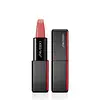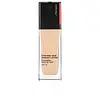What's inside
What's inside
 Key Ingredients
Key Ingredients

 Benefits
Benefits

 Concerns
Concerns

 Ingredients Side-by-side
Ingredients Side-by-side

Mica
Cosmetic ColorantDimethicone
EmollientNeopentyl Glycol Dicaprate
EmollientPolyethylene
AbrasiveDiisostearyl Malate
EmollientSynthetic Fluorphlogopite
Titanium Dioxide
Cosmetic ColorantGlyceryl Diisostearate
EmollientCI 15850
Cosmetic ColorantMicrocrystalline Wax
Emulsion StabilisingTriisostearin
Skin ConditioningCI 77491
Cosmetic ColorantTrimethylolpropane Triethylhexanoate
EmollientCI 77492
Cosmetic ColorantCI 77499
Cosmetic ColorantMethicone
EmollientAluminum Hydroxide
EmollientTetradecene
EmollientSilica
AbrasivePolysilicone-2
Tocopherol
AntioxidantCalcium Stearate
Cosmetic ColorantSimethicone
EmollientBHT
AntioxidantCI 19140
Cosmetic ColorantCI 15985
Cosmetic ColorantCI 42090
Cosmetic ColorantMica, Dimethicone, Neopentyl Glycol Dicaprate, Polyethylene, Diisostearyl Malate, Synthetic Fluorphlogopite, Titanium Dioxide, Glyceryl Diisostearate, CI 15850, Microcrystalline Wax, Triisostearin, CI 77491, Trimethylolpropane Triethylhexanoate, CI 77492, CI 77499, Methicone, Aluminum Hydroxide, Tetradecene, Silica, Polysilicone-2, Tocopherol, Calcium Stearate, Simethicone, BHT, CI 19140, CI 15985, CI 42090
Ethylhexyl Methoxycinnamate 6.9%
UV AbsorberTitanium Dioxide 1%
Cosmetic ColorantWater
Skin ConditioningDimethicone
EmollientDiphenylsiloxy Phenyl Trimethicone
Skin ConditioningGlycerin
HumectantTrifluoropropyldimethyl/Trimethylsiloxysilicate
EmollientButylene Glycol
HumectantHydrogenated Polydecene
EmollientPEG-10 Dimethicone
Skin ConditioningBis-Butyldimethicone Polyglyceryl-3
CleansingDisteardimonium Hectorite
StabilisingErythritol
HumectantXylitol
HumectantSorbitan Sesquiisostearate
EmulsifyingPolyquaternium-51
Skin ConditioningCitrus Unshiu Peel Extract
MaskingThymus Serpyllum Extract
Skin ConditioningFagus Sylvatica Bud Extract
TonicHydrolyzed Conchiolin Protein
Skin ConditioningDimethicone/Vinyl Dimethicone Crosspolymer
Skin ConditioningDimethicone/PEG-10/15 Crosspolymer
CI 77120
Cosmetic ColorantSynthetic Fluorphlogopite
Aluminum Hydroxide
EmollientPolysilicone-2
Disodium EDTA
Stearic Acid
CleansingCalcium Aluminum Borosilicate
Tocopherol
AntioxidantDipropylene Glycol
HumectantTriethoxycaprylylsilane
Triethoxysilylethyl Polydimethylsiloxyethyl Dimethicone
Skin ConditioningBHT
AntioxidantAlumina
AbrasivePolymethylsilsesquioxane
Phenoxyethanol
PreservativeIron Oxides
Mica
Cosmetic ColorantEthylhexyl Methoxycinnamate 6.9%, Titanium Dioxide 1%, Water, Dimethicone, Diphenylsiloxy Phenyl Trimethicone, Glycerin, Trifluoropropyldimethyl/Trimethylsiloxysilicate, Butylene Glycol, Hydrogenated Polydecene, PEG-10 Dimethicone, Bis-Butyldimethicone Polyglyceryl-3, Disteardimonium Hectorite, Erythritol, Xylitol, Sorbitan Sesquiisostearate, Polyquaternium-51, Citrus Unshiu Peel Extract, Thymus Serpyllum Extract, Fagus Sylvatica Bud Extract, Hydrolyzed Conchiolin Protein, Dimethicone/Vinyl Dimethicone Crosspolymer, Dimethicone/PEG-10/15 Crosspolymer, CI 77120, Synthetic Fluorphlogopite, Aluminum Hydroxide, Polysilicone-2, Disodium EDTA, Stearic Acid, Calcium Aluminum Borosilicate, Tocopherol, Dipropylene Glycol, Triethoxycaprylylsilane, Triethoxysilylethyl Polydimethylsiloxyethyl Dimethicone, BHT, Alumina, Polymethylsilsesquioxane, Phenoxyethanol, Iron Oxides, Mica
Ingredients Explained
These ingredients are found in both products.
Ingredients higher up in an ingredient list are typically present in a larger amount.
Aluminum Hydroxide is a form of aluminum. It can be naturally found in nature as the mineral gibbsite. In cosmetics, Aluminum Hydroxide is used as a colorant, pH adjuster, and absorbent.
As a colorant, Aluminum Hydroxide may add opacity, or reduce the transparency. Aluminum hydroxide is contains both basic and acidic properties.
According to manufacturers, this ingredient is an emollient and humectant. This means it helps hydrate the skin.
In medicine, this ingredient is used to help relieve heartburn and help heal ulcers.
There is currently no credible scientific evidence linking aluminum hydroxide in cosmetics to increased cancer risk.
Major health organizations allow the use of aluminum hydroxide in personal care products and have not flagged it as a carcinogenic risk at typical usage levels.
Learn more about Aluminum HydroxideBHT is a synthetic antioxidant and preservative.
As an antioxidant, it helps your body fight off free-radicals. Free-radicals are molecules that may damage your skin cells.
As a preservative, it is used to stabilize products and prevent them from degrading. Specifically, BHT prevents degradation from oxidation.
The concerns related to BHT come from oral studies; this ingredient is currently allowed for use by both the FDA and EU.
However, it was recently restricted for use in the UK as of April 2024.
Learn more about BHTDimethicone is a type of synthetic silicone created from natural materials such as quartz.
What it does:
Dimethicone comes in different viscosities:
Depending on the viscosity, dimethicone has different properties.
Ingredients lists don't always show which type is used, so we recommend reaching out to the brand if you have questions about the viscosity.
This ingredient is unlikely to cause irritation because it does not get absorbed into skin. However, people with silicone allergies should be careful about using this ingredient.
Note: Dimethicone may contribute to pilling. This is because it is not oil or water soluble, so pilling may occur when layered with products. When mixed with heavy oils in a formula, the outcome is also quite greasy.
Learn more about DimethiconeMica is a naturally occurring mineral used to add shimmer and color in cosmetics. It can also help improve the texture of a product or give it an opaque, white/silver color.
Serecite is the name for very fine but ragged grains of mica.
This ingredient is often coated with metal oxides like titanium dioxide. Trace amounts of heavy metals may be found in mica, but these metals are not harmful in our personal products.
Mica has been used since prehistoric times throughout the world. Ancient Egyptian, Indian, Greek, Roman, Aztec, and Chinese civilizations have used mica.
Learn more about MicaPolysilicone-2 is a type of silicone.
Synthetic Fluorphlogopite is the synthethic version of mica. It consists of fluorine, aluminum and silicate.
Synthetic Fluorphlogopite is used to add volume to products.
It is considered non-irritating on the skin.
Learn more about Synthetic FluorphlogopiteTitanium dioxide is a mineral UV filter widely used in sunscreens and cosmetics.
It is one of only two UV filters officially classified as “mineral” by regulatory agencies, the other being zinc oxide.
Titanium dioxide provides broad-spectrum protection mostly in the UVB and UVAII range, with some protection in the UVAI range.
While its UVA protection isn’t as strong as zinc oxide’s, the difference is minor.
A common myth is that mineral UV filters reflect UV light. However, modern research shows titanium dioxide absorbs UV radiation like chemical filters (~95% absorption & 5% reflection).
Thanks to its non-irritating nature, titanium dioxide is suitable for sensitive, acne-prone, or redness-prone skin. It is unlikely to cause "eye sting" like other sunscreen ingredients.
A major drawback of this ingredient is its white cast and thick texture. This is why mineral sunscreens often leave a white cast and are less cosmetically elegant than chemical/hybrid sunscreens.
To improve white cast and spreadability, micronized or nano-sized titanium dioxide is often used.
There are ongoing concerns surrounding nano-titanium oxide's impact on marine ecosystems.
There is no conclusive evidence that any form of titanium oxide (or any other sunscreen ingredients) will cause harm to marine ecosystems or coral reefs. The science is still developing but many consumers are keeping a close eye on this issue.
Please note, many destinations have reef-safety sunscreen rules. For instance, the U.S. Virgin Islands advises all visitors to use non-nano mineral sunscreens.
Nano mineral sunscreens once raised safety concerns about absorption into skin.
Extensive research has shown that they do not penetrate healthy or damaged skin; they remain safely on the surface and the top layer of dead skin (stratum corneum).
You'll likely find titanium dioxide bundled with alumina, silica, or dimethicone. These ingredients help make titanium dioxide highly photostable; this prevents it from interacting with other formula components under UV light.
Learn more about Titanium DioxideTocopherol (also known as Vitamin E) is a common antioxidant used to help protect the skin from free-radicals and strengthen the skin barrier. It's also fat soluble - this means our skin is great at absorbing it.
Vitamin E also helps keep your natural skin lipids healthy. Your lipid skin barrier naturally consists of lipids, ceramides, and fatty acids. Vitamin E offers extra protection for your skin’s lipid barrier, keeping your skin healthy and nourished.
Another benefit is a bit of UV protection. Vitamin E helps reduce the damage caused by UVB rays. (It should not replace your sunscreen). Combining it with Vitamin C can decrease sunburned cells and hyperpigmentation after UV exposure.
You might have noticed Vitamin E + C often paired together. This is because it is great at stabilizing Vitamin C. Using the two together helps increase the effectiveness of both ingredients.
There are often claims that Vitamin E can reduce/prevent scarring, but these claims haven't been confirmed by scientific research.
Learn more about Tocopherol